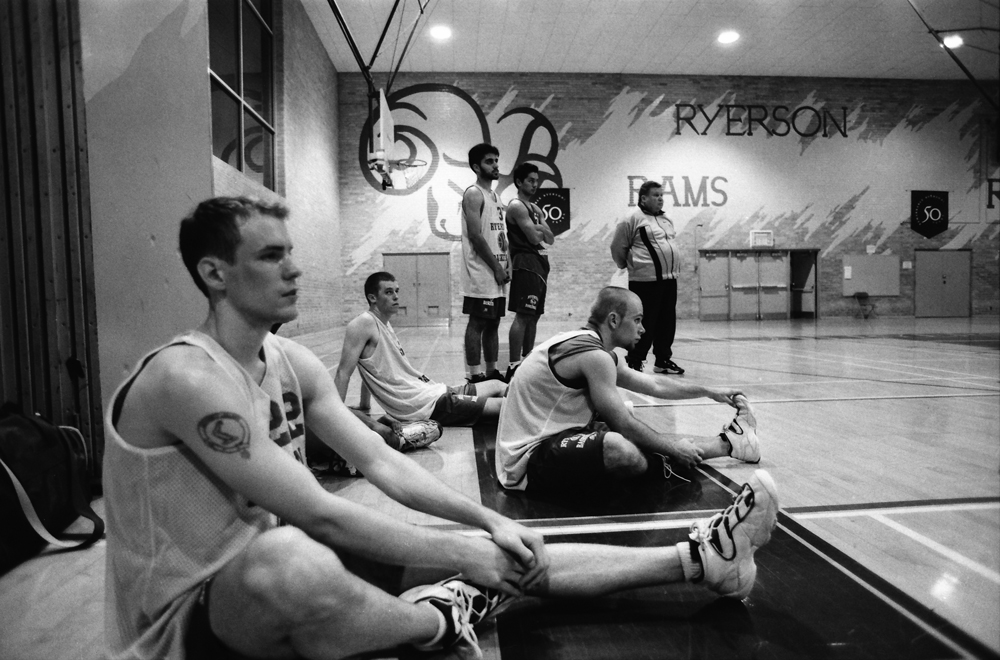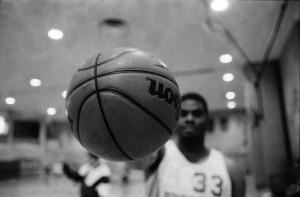By Caroline Alphonso
Ryerson’s athletic department is crammed into a tiny corner above the Kerr gyms. The well-lit office could easily be mistaken for a classroom. The main entrance is home to both the receptionist and the department’s marketing wing, the two desks sit not fix feet apart. Off to the left side of the room are two doors in a tiny enclave. One door leads into the athletic department archives where an old hockey jersey hangs from the ceiling against one wall, and a small bookcase on the other wall houses the archives.
The other door leads into the office of the men’s basketball coach Terry Haggerty. Haggerty holds the distinction of being the only Ryerson coach with a spot inside the athletic office. The women’s basketball coach has a tiny office down the hall and around the corner from the gym. Towards the back of the main room, behind a six foot high cubicle, is Chuck Mathies, assistant athletic director. Beside him is the office of the elder statesman of the athletic department, Bob Fullerton.
Fullerton has been at Ryerson for the past 31 years. When he first arrived here, he taught business. Now, he is trying to stretch Ryerson’s small athletic budget dollar into some form of success. The top of his large wooden desk is cluttered with reports and papers. On a separate desk, towards the side of his office, are neatly placed framed pictures of his six daughters.
Fullerton’s experience in sports is extensive. While studying business at the University of Western Ontario in 1956, he played football and wrestled at the varsity level. At the intramural level, he played hockey, basketball, hand ball (squash) and competed in track and field.
Now, at 62, Fullerton’s knees are weak and he is unable to work out as much as he would like to. He still bikes from his home in the Beaches to Ryerson for six months of the year. When he reaches his office in West Kerr, he sits down to his responsibility helping make Ryerson’s varsity squads competitive.
“Our teams are a lot better than they were [back when I started in 1967],” he said. “Competition is a lot better now.”
The increased competition has left Ryerson scrambling to keep up with better-funded Ontario University Athletic association counterparts. The strength of varsity sports is tied to the funding teams receive to keep their competitive edge.
Without adequate athletic funding, Ryerson teams find it harder to compete with other universities across the country. Without enough cash, the athletics department will see a decrease in fan support. No coin also means a lack of adequate facilities on campus. And without fans and facilities, Ryerson has a harder time recruiting athletes.
Ryerson’s annual athletic department funding is $619, 875. Each full-time student contributes $49.59 out of their fees.
In Ontario, universities with enrolment numbers similar to Ryerson have budgets exceeding $1 million. The University of Windsor, for example, has a student population comparable to Ryerson. Windsor’s athletic budget is $1.3 million. Students pay $92 from fees and the university contributes $260, 000 that goes towards salaries. To top that off, an additional $75, 000 is brought in through advertising, alumni contributions and sponsorships. Ryerson, meanwhile, is left wondering why its alumni don’t send their forwarding addresses.
Even though other universities get more money than Ryerson, they complain of the lack of funds.
John MacLean, director of athletics and recreation at Windsor, said she would like to have enough cash to build a new stadium for the Lancers football and soccer teams to play in.
For Ryerson, the chances of having a new stadium built are as good as having a book less than 40 years old in the library. Also, the lack of green space on campus means teams like soccer have to walk for almost a half hour to practice.
***
On a cold Thursday evening, the 16 women’s soccer players make the 25-minute walk to Riverdale Park. It’s the best place for them to practice because Ryerson doesn’t have an on-campus soccer field. The alternative to Riverdale is Moss Park. Closer than Riverdale, Moss Park is at the corner of Queen and Sherbourne, and it is not in the most friendly neighbourhood. It’s kind of a lose-lose situation for the Ryerson soccer players.
Coach Jon Sanderson is a genial drill sergeant, alternately barking out order and shouting encouragement to his players. He has them running up and down the field, doing push-ups, sit-ups and “burpies” (dropping to a push-up stance and then quickly jumping up repeatedly).
The upbeat Sanderson is not discouraged by the obstacles his team faces. He’s infected with the same love for the game that his players have.
“This is a good fit for me,” the first-year coach says. “Hopefully I can develop the girls as well as they can help me develop at this level.”
Sanderson hopes to develop discipline in his players that he thinks has been lacking from many of Ryerson’s teams in past years.
“Commitment over the last few seasons has been less than I’d want as a coach. It was a little bit, come and go as you please,” Sanderson said. “I want to instill that you have to work hard to stay on this term.”
As the sun descends from the rain cloud-blanketed sky, the players can feel the strong, cold wind. Their lungs burn from gasping the cold, fall air. They shiver as the wind chills the sweat from their pores. It’s about 12 degrees, but much colder with the steady wind.
When they get a break, most of the players who brought extra clothes stagger to the sideline to bundle up against the impending sunset.
When practice is over, they have to walk back to Ryerson again. After such a long day, the trip back is undoubtedly a longer one.
Ryerson does not have the luxury of housing all their teams on-campus. Every other school in Ontario has the space for all their teams. All Ryerson has is a pool and the Kerr Hall gyms. This leaves many of our teams out in the lurch in terms of where they can play. Our soccer teams have to travel for about an hour to Birchmount Stadium in Scarborough for their home games. Our hockey team has to go all the way to Bathurst and St. Clair for their home games at St. Mike’s arena. These long trips to soccer fields and ice rinks are all too familiar to Ryerson athletes.
Even though the hockey team gets to use the nearby Maple Leaf Gardens, the only real icetime they can get is at 7:30 a.m. On the other hand, York University has the Ice Garden on campus. This fairly new arena is open to York’s hockey team whenever they want it.
Ryerson is located in the downtown core, which makes development, building and expansion impossible. As a result, Rye’s athletes have a hell of a time getting to soccer games at Birchmount Stadium in Scarborough or The Arc in Mississauga for figure skating, both of which are far off the subway lines.
Ryerson doesn’t have a whole lot of people living near the school. It’s unfair to ask the majority of students to add an extra half hour to their commute just to watch a game.
***
It’s a sunny and warm Sunday. The women’s soccer team is playing the provincial champion, the Ottawa Gee Gees, at Birchmount. There is not a cloud in the sky, and the temperature is around 24 degrees. The Rams keep close to the powerful Ottawa team for the first half, only to lose it in the second. It is so quiet at the stadium, you can hear the grass bending beneath the players’ cleats.
Ryerson ends up losing 5-0. Nobdoy knows except for the two Ryerson reporters who came to cover the game.
In Hamilton, McMaster University is experiencing a subtle boost in their attendance figures at home games.
“Attendance is building because teams are developing and are much stronger,” said Therese Quigley, director of athletics and recreation for the Marauders.
McMaster has an athletic budget of more than $2 million. Students are charged $2 admission for basketball, volleyball and football home dates.
All the money McMaster makes from admission and concessions is recycled back into the games in the form of prizes and contests.
Athletics can play an important role in boosting school spirit. In preparation for their homecoming game held on Oct. 3, there was a kickoff barbecue with football players serving hot dogs and hamburgers. It was a festival atmosphere, with clowns, jugglers and baton twirlers, said Trish Chant, co-ordinator communication and media relations.
“If we provide a good product to students, they’ll keep coming back,” she said.
Of course, Ryerson’s story is not quite as happy. The incredible lack of fan support at Ryerson sporting events has the athletic department looking for new marketing ideas. Now, upcoming team games are announced through posters around the school. Unfortunately, the posters are stapled on high traffic bulletin boards; so the athletics promos are plastered over almost as soon as they’re put up. One of athletics’ ideas is to use Ryerson marketing students have may have fresh ideas on how to get students out to the games.
But the best way to promote teams and build notoriety for the school is through high profile players and teams.
Ryerson has had high profile athletes in the past, and not even their accomplishments could garner any Rye support.
***
The stands inside the U of T pool are packed to the rafters. Parents, friends and supporters all scream at the top of their lungs to cheer their team. The Ryerson swim team, however, doesn’t have a booster club. Besides the swimmers, a few Ryerson journalism students, and frequent visits from president Claude Lajeunesse, there are no Ryerson students here
Banner are draped over the rails of the upper stands. Brock, Western, Carleton and U of T all have massive banners screaming support for their school. Ryerson’s sign is modest. A quiet vote of confidence from a school that doesn’t care what is going on.
Ryerson swimmer Marie-Claire Ross has won two standing ovation son this cold February weekend, on when she accepted her silver medal, and one with her bronze.
She has capture the heart of every fan in the stands; not one of those hearts beat for a Ryerson student.
Ross is a fourth-year nutrition student at Ryerson. She is also a legally blind swimmer who broke four world records at the 1998 Ontario championships at U of T. The year before that, she became the first blind woman to qualify to swim at the Canadian championships. Not to mention she was the first Ryerson female to qualify since 1984.
Legally blind since she was 8, the then 22-year-old had only 10 per cent of her vision. She uses the thick black line along the bottom of the pool to guide her during her swim.
Ross wasn’t a competitive swimmer before she came to Ryerson. The school just sort of lucky out when she enrolled and became a star. There was no athletic lure to attract her to Ryerson, it was the nutrition course that did that.
Ryerson doesn’t have many high profile athletes left. Since the school lacks notoriety, recruiting athletes is even harder.
Other universities have an easier time recruiting players. Typically, athletes look for a university that has a physical education program. Most universities have one. Ryerson doesn’t.
Another factor that works against Ryerson is the fact that the school only offers programs that last a maximum of four years. Other universities offer programs that last up to five years. This means that after Ryerson’s seniors graduate and the rookies take over, they will be playing other teams that have been together for five years.
Ryerson has never won a provincial championship in any sport.
“People like to come out to see a winning team,” said David Copp, director of athletics at the University of Guelph. The football stadium, which seats 5,000 is filled to 6,000 when the Gryphons play good teams. On a couple of occasions, 10,000 have showed up to a football game, he said.
Like Guelph, Ryerson belongs to the Ontario University Athletics association.
Besides their membership in the OUA, Ryerson and Guelph have few things in common. Ryerson has never won anything significant. Meanwhile, Guelph has enjoyed great success with their hockey and football programs. The success of the teams in Guelph breeds fan excitement, an excitement the Rams have never been able to generate.
“We are very competitive in every game we play,” said Chuck Mathies, assistant athletics director. Last year, the women’s basketball game made it to the playoffs.
But with a tight budget, Ryerson athletics has no room to manoeuvre to make its teams more competitive. “What we have is what we work with,” he said.













Leave a Reply